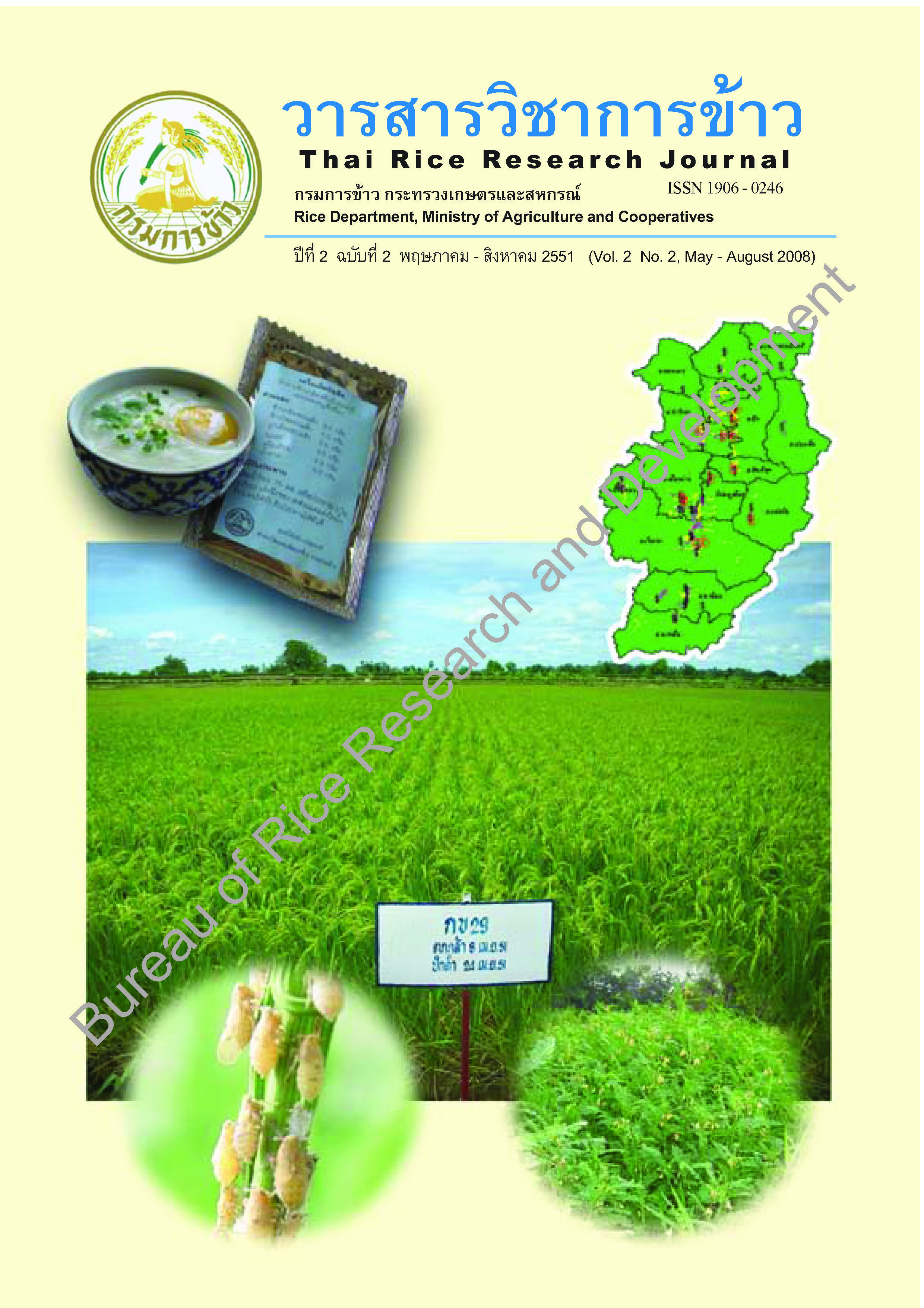โจ๊กกึ่งสำเร็จรูปจากข้าวกล้องงอก
Main Article Content
บทคัดย่อ
การทำข้าวกล้องงอก เป็นนวัตกรรมของการเพิ่มสารอาหารที่เป็นประโยชน์ต่อสุขภาพและเพิ่มมูลค่าของข้าว การนําข้าวกล้องงอกมาแปรรูปเป็นโจ๊กกึ่งสําเร็จรูป ทำให้สะดวกและรวดเร็วในการปรุงเป็นอาหาร จากการศึกษาวิธีทำข้าวกล้องงอกเพื่อให้เกิดสารอาหาร และสารต้านอนุมูลอิสระสูงสุด ในข้าวพันธุ์ขาวดอกมะลิ 105 และปทุมธานี 1 โดยการเพาะข้าวกล้องให้งอกในเวลา 22 และ 26 ชม. ทั้งห้องทดลองในสภาพปกติและสภาพมืดที่อุณหภูมิ 30 °ซ. พบว่า การเพาะในสภาพมืดเป็นเวลา 26 ชม. ทำให้ปริมาณสารอาหารและสารต้านอนุมูลอิสระเพิ่มขึ้นสูงสุดในข้าว กล้องงอกของข้าวทดสอบทั้ง 2 พันธุ์ มี amino acids โดยรวม 18-19 มก./100 กรัม มากกว่าในข้าวสารประมาณ 60 เท่า ปริมาณโปรตีนในข้าวกล้องงอกเพิ่มขึ้นจากข้าวกล้องและข้าวสารเพียงเล็กน้อย ปริมาณน้ำตาลเชิงเดียวที่เกิดขึ้น ในข้าวกล้องงอก 1,003 - 1,058 มก./100 กรัม สูงกว่าในข้าวสารประมาณ 4 - 6 เท่า และสารต้านอนุมูลอิสระพวก phenolic compounds ในข้าวกล้องงอก เพิ่มมากกว่าในข้าวสารและข้าวกล้อง 59-65 มก./100 กรัม การเพาะข้าวกล้องที่ใช้เวลา 26 ชั่วโมงในสภาพมืดให้ปริมาณ gamma oryzanol สูงสุดคือ 45 - 56 มก./100 กรัม ได้นําข้าวกล้องงอกที่เพาะเป็นเวลา 26 ชม. ในสภาพมืดไปทำโจ๊กกึ่งสำเร็จรูปบรรจุในถุงอลูมินั่มฟอยล์เพื่อศึกษาอายุการเก็บรักษา โดยทดสอบความชอบทางประสาทสัมผัส พบว่า ผู้ชิมให้การยอมรับระดับดี - ปานกลาง ทั้งรสชาติ ความข้นใส และกลิ่นโจ๊กกึ่งสำเร็จรูปสามารถเก็บไว้ได้ในสภาพอุณหภูมิห้องนาน 5 เดือน
Article Details
เอกสารอ้างอิง
AOAC. 1990. Official Method of Analysis. 15th ed. Association of the Analytical Chemists. AOAC, Washington, DC. 1,298 p.
Beasley, Z. 2004. Soaking brown rice increase its nutritional value. American Chemical Society, December 16, 2000.
DOMER company. 2004. GBR's Power. December 16, 2004. Available source : http://hatsuga.com.
Emmons, L.C., D.M. Peterson and G.L. Paul. 1999. Antioxidant capacity of oat (Avena sativa L.) extracts. 2. In vitro antioxidant activity and contents of phenolic and tocol antioxidants. J. Agric. Food Chem. 47(12) : 4894-4898.
Kamatsuzaki, N., T. Kikuichi, T. Hidechika, S. Tadanao, S. Naoto and K. Toshinori. 2007. Effect of soaking and gaseous treatment on GABA content in germinated brown rice. J. Food Eng. 78 : 556-560.
Miller, G.L. 1959. Use of dinitrosalicylic acid reagent for determination of reducing sugar. Biotechnol. Bioeny. 5 : 193.
Osawa, M.Z., K. Goto and K. Tsukahara. 2004. Clinical study of germinated brown rice on Sawapikari. World Rice Research Conference 2004, 5-7 November, 2004. Tsukuba International Congress Center (Epochal Tsukuba) Tsukuba, Ibaraki, Japan.
Rong, N., L.M. Ausman and R.J. Nicolosi. 1997. Oryzanol decreases cholesterol absorption and aortic fatty streaks in hamsters. Lipids 32 : 303-309.
Seki, T., R. Nagase, M. Torimitsu, M. Yanagi, Y. Ito, M. Kise, A. Mizukuchi, K. Hayamizu and T. Ariga. 2005. Insoluble fiber is a major constituent responsible for post-prandial blood glucose concentration in the pre - germinated brown rice. Biol. Pharm. Bull. 28(8) : 1539-1542.
Tian, S., K. Nakamura and H. Kayahara. 2004. Analysis of phenolic compounds in white rice, brown rice and germinated brown rice. J. Agric. Food Chem. 52 : 4808-4813.
Varanyanoud, W., P. Tungtrakul, V. Surojanametakul, L. Watanasirithum and W. Luxiang. 2005. Effect of water soaking on gamma-aminobutyric acid (GABA) in germ of different Thai rice varieties. Kasetsart J. (Nat. Sci.) 39 : 411-415.
Xu, Z. and J.S. Godber. 2000. Comparison of supercritical fluid and solvent extraction methods in extracting oryzanol from rice bran. JOACS, 77(5).
Zhou, Z., K. Robards, S. Helliwell and C. Baanchard. 2004. The distribution of phenolic acids in rice. Food Chem. 87 : 401-406.

